Ornamental alliums are a beautiful addition to any garden, with their stunning globe-shaped flowers and unique look. But how do you plant and care for them to ensure they thrive in your garden?
Here, we’ll cover everything you need to know about how to plant and care for ornamental alliums. From selecting the right varieties for your garden to choosing the perfect location for planting, we’ll give you tips and techniques to ensure your alliums grow strong and healthy.
We’ll also cover caring for your plants, including watering, fertilizing, and mulching, as well as pruning and deadheading tips. If you’re experiencing common pests or diseases with your alliums, we’ve got you covered, too. Lastly, we’ll share some creative uses for ornamental alliums in the garden and how to harvest and store their seeds.
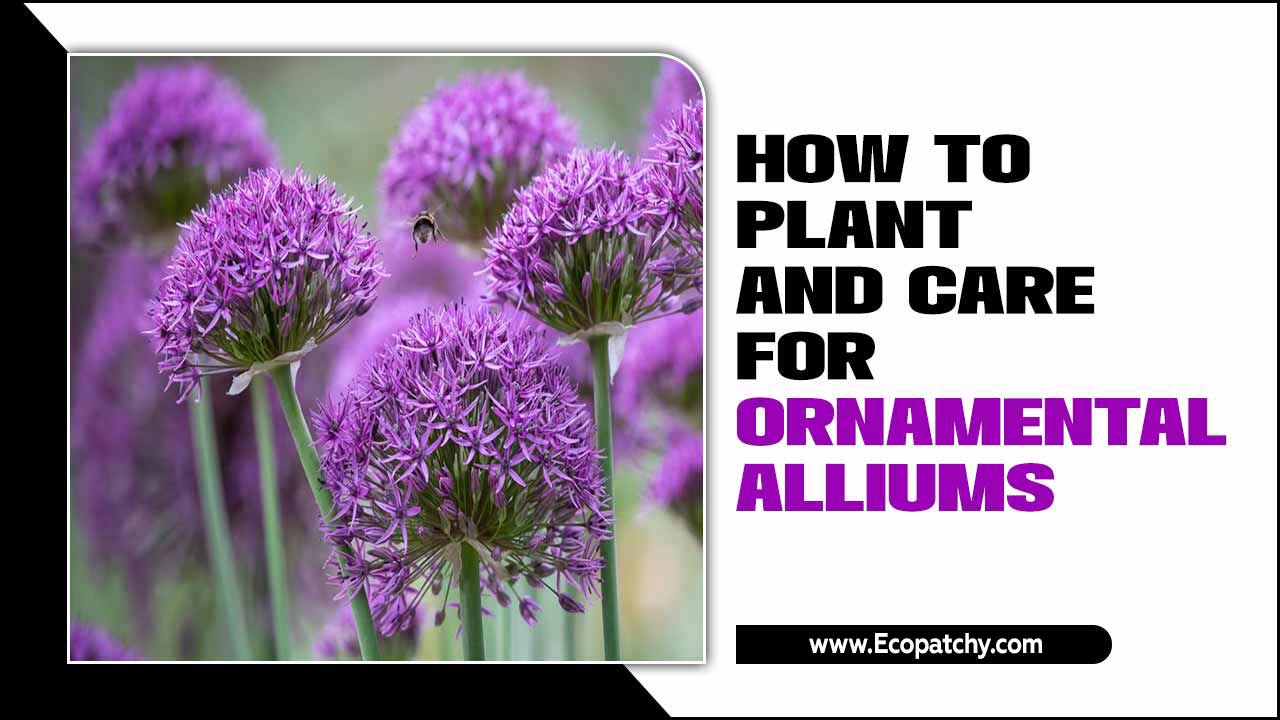
About Ornamental Alliums

Ornamental alliums are a beautiful addition to any garden or landscape. These flowering bulbs belong to the same family as onions and garlic, but don’t worry – they won’t make your garden smell like a kitchen! Ornamental alliums come in various sizes and colours, ranging from small globes to tall spires.
They are known for their unique spherical flower heads that can add height and texture to your garden beds. Planting ornamental alliums is relatively easy – dig a hole, place the bulb in the ground with the pointy end, and thoroughly cover it with soil and water.
These plants prefer well-draining soil and full sun, so choose a location that meets these requirements. Once planted, ornamental alliums require minimal care. Water regularly during dry spells, remove dead flowers or foliage, and divide overcrowded clumps every few years to maintain their health and vigour. With proper care, you can enjoy the beauty of ornamental alliums in your garden year after year.
Selecting The Right Allium Varieties For Your Garden
Selecting the right varieties is key when planting and caring for ornamental alliums. By considering these factors, you can ensure that you select the right allium varieties for your garden and create a stunning display of colourful and unique flowers. Here are some factors to consider when choosing the perfect alliums for your garden:
- Height: Alliums come in various sizes, from small and compact varieties to tall and majestic ones. Consider the height that would work best in your garden and complement your existing plants.
- Flower Shape And Colour: Allium flowers can vary, ranging from round clusters to more elongated shapes. They come in various colours, including shades of purple, pink, white, and yellow. Choose flowers that will harmonize with your garden’s colour scheme.
- Bloom Time: Alliums bloom at different times throughout the year. Some flower in early spring, while others bloom in late summer or fall. Consider when you want your alliums to bloom and select varieties accordingly.
- Sunlight Requirements: Most alliums thrive in full sun but can tolerate partial shade. Assess the sunlight your garden receives and choose allium varieties that will thrive in those conditions.
Choosing The Perfect Location For Planting Alliums
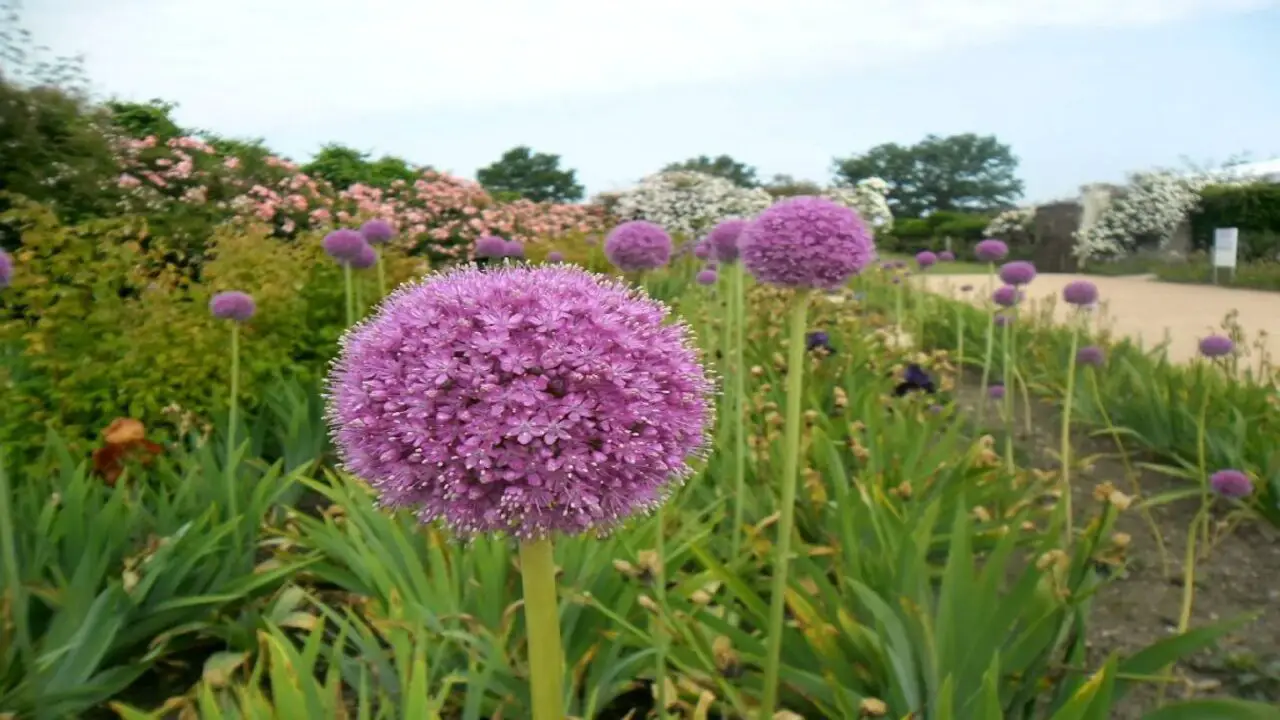
Choosing the perfect location for planting alliums is crucial to their growth and overall health. These beautiful ornamental plants thrive in full sun, so selecting a spot in your garden that receives at least 6-8 hours of direct sunlight each day is important.
Additionally, alliums prefer well-drained soil, so choose an area that does not retain water or become waterlogged after rainfall. It is also recommended to plant alliums in a location with good air circulation to prevent the development of fungal diseases. By carefully considering these factors and selecting the right location, you can ensure that your alliums will flourish and bring vibrant colour and beauty to your garden.
5 Steps For How To Plant And Care For Ornamental Alliums
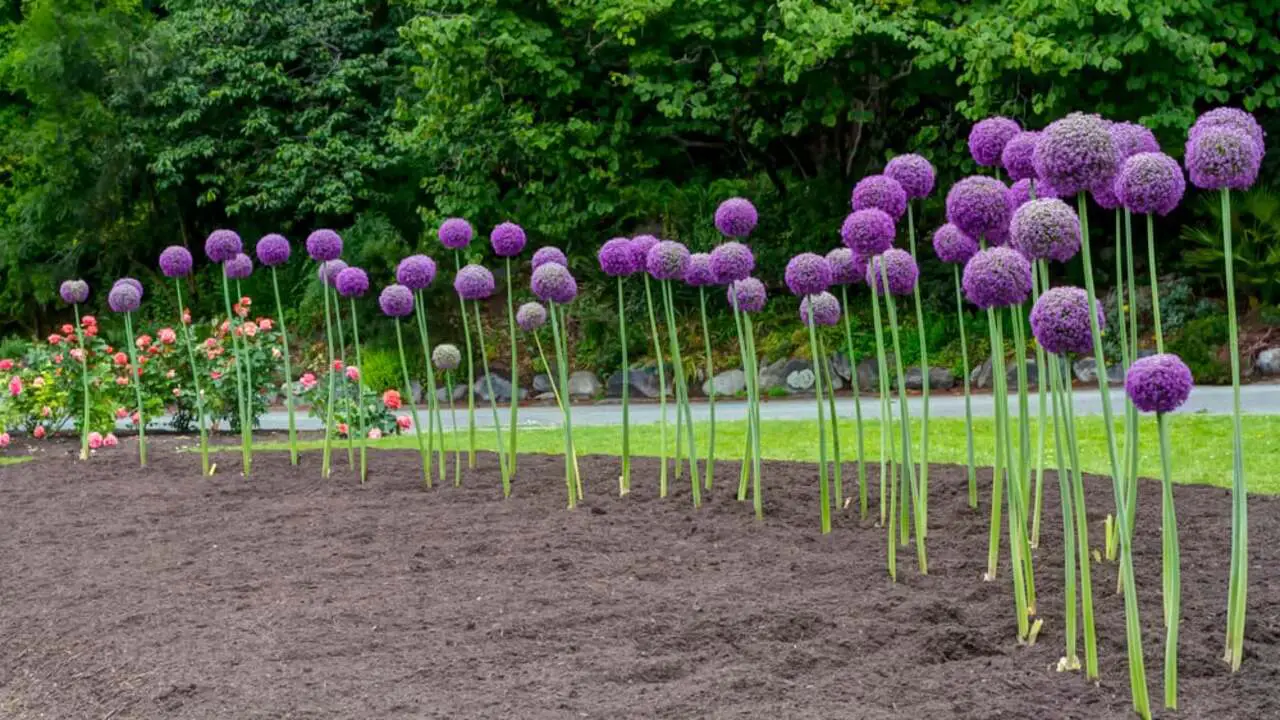
When adding beauty and elegance to your garden, ornamental alliums are an excellent choice. These stunning flowering plants are known for their vibrant colours and unique spherical blooms. Here are five essential tips to remember to ensure the successful growth and maintenance of these how to plant and care for ornamental alliums.
1.Planting Techniques For Allium Bulbs
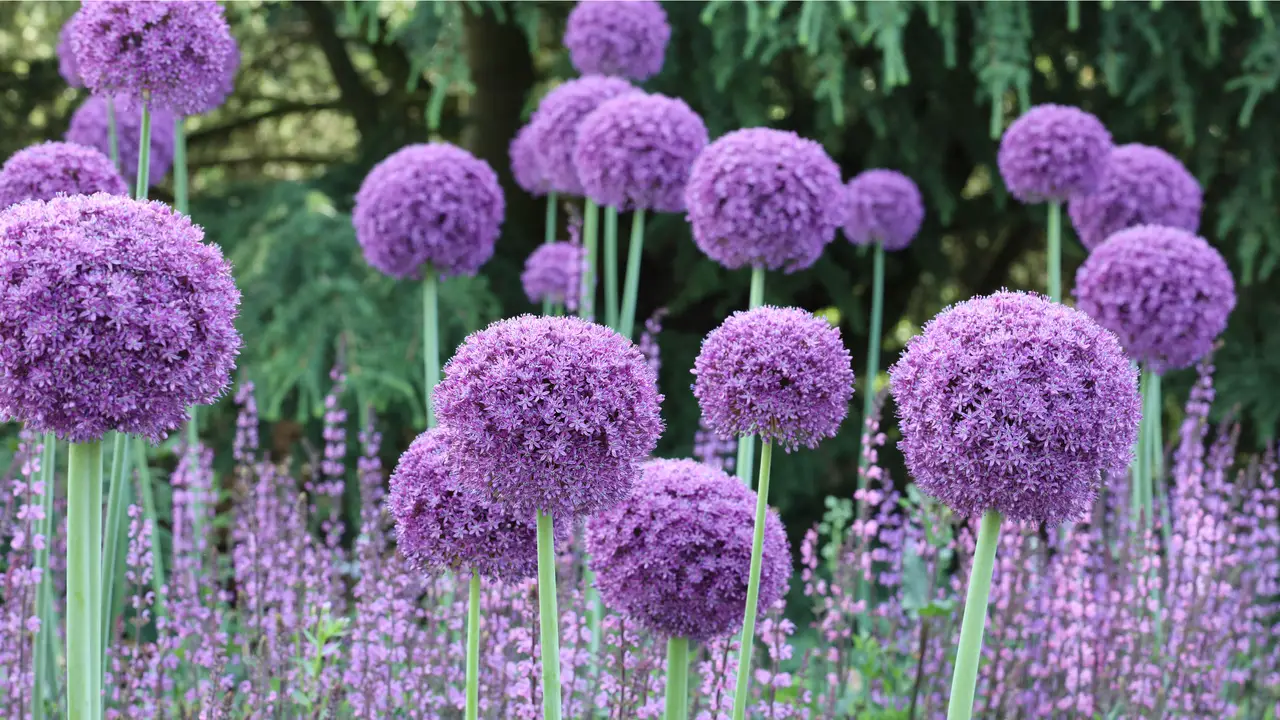
Planting allium bulbs is a straightforward process that can yield stunning results in your garden. To begin, choose a location with full sun and well-draining soil. Dig a hole two to three times deeper than the bulb’s height, placing the bulb with the pointed end facing upwards.
Space the bulbs several inches apart to allow for adequate growth. After planting, water thoroughly to settle the soil and encourage root development. Throughout the growing season, provide regular watering and ensure the soil remains moist but not waterlogged. You can enjoy the alliums’ vibrant colours and unique spherical shapes as they bloom. Your ornamental alliums will thrive and add beauty to your garden landscape with proper care and attention.
2.Caring For Alliums: Watering, Fertilizing, And Mulching
Proper care is essential for the health and longevity of ornamental alliums. When it comes to watering, it is important to strike a balance. Alliums prefer evenly moist soil but not waterlogged, so be sure to water them deeply once a week, especially during dry spells.
Fertilizing is also important to provide the necessary nutrients for healthy growth. Apply a balanced granular fertilizer in early spring, following the package instructions. Mulching can help conserve moisture and suppress weeds around the base of the plants.
Use a layer of organic mulch, such as compost or straw, being careful not to bury the foliage or stems. Following these care guidelines ensures that your ornamental alliums thrive and add beauty to your garden.
3.Pruning And Deadheading Alliums For Optimal Growth
Pruning and deadheading alliums is an important aspect of their care to ensure optimal growth and longevity. Then, Pruning involves removing any dead or damaged foliage and flowers, which improves the plant’s appearance and helps prevent the spread of disease.
It is recommended to prune alliums after they have finished flowering, allowing them to divert their energy towards bulb development. Deadheading involves removing spent flower heads to encourage further blooming and prevent self-seeding. Regularly pruning and deadheading your alliums can promote healthy growth and vibrant blooms season after season.
4.Dealing With Common Pests And Diseases
When planting and caring for ornamental alliums, knowing about common pests and diseases affecting these beautiful flowers is important. One common pest that may target alliums is the onion fly, which lays its eggs on the leaves and stems. To prevent infestations, you can use row covers or insecticides specifically designed to target onion flies. Another potential pest is the bulb mite, which can cause damage to the bulbs and lead to stunted growth.
If you notice any bulb mite infestation, removing and destroying affected bulbs is best. In terms of diseases, alliums are susceptible to fungal infections such as botrytis (grey mould) and downy mildew. To prevent these diseases, ensure adequate air circulation and avoid overwatering.
Additionally, practising good garden hygiene by removing any dead or decaying plant material can help prevent the spread of disease. By being vigilant and taking proactive measures, you can ensure that your ornamental alliums thrive and remain healthy throughout the growing season.
5.Propagating Alliums: Dividing And Transplanting
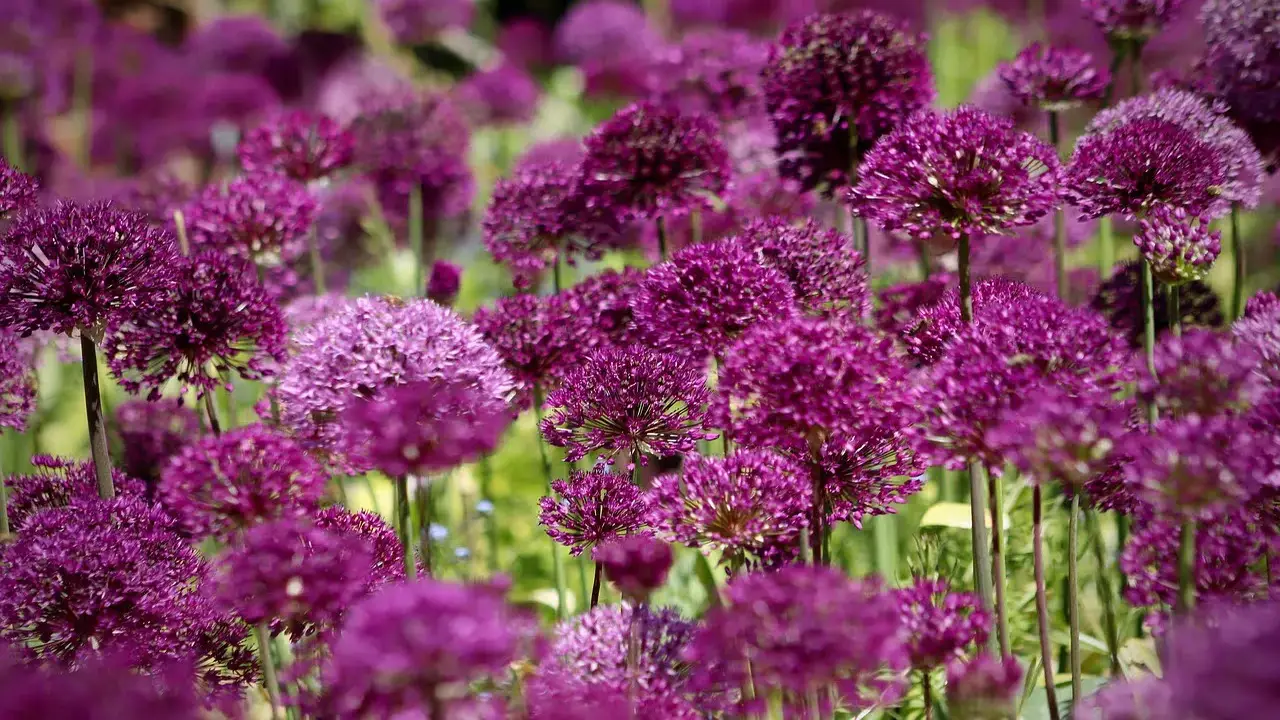
Dividing and transplanting ornamental alliums can be a great way to propagate these beautiful flowers and create new plants. The best time to divide and transplant alliums is in the fall, after the foliage has died. Start by carefully digging up the clump of allium bulbs, careful not to damage them.
Gently separate the bulbs, ensuring each division has its roots and foliage. Replant the divisions in well-draining soil, spacing them out according to their mature size.
Water thoroughly after planting and continue regularly until the plants are established. Dividing and transplanting alliums can help rejuvenate crowded clumps and allow you to spread these stunning flowers throughout your garden.
Tips For Maintaining Alliums
Taking care of ornamental alliums is relatively easy, and with a few simple tips, you can ensure that they thrive in your garden. Following these maintenance tips, you can enjoy beautiful blooms from your ornamental alliums year after year. Here are some key points to keep in mind:
- Planting: Choose a sunny location with well-drained soil for your alliums. Plant the bulbs in the fall, about 6-8 inches deep and 6-8 inches apart.
- Watering: Alliums prefer dry soil, so be careful not to overwater them—water sparingly, especially during the summer months when rainfall is more common.
- Fertilizing: Alliums don’t require much fertilization. A light application of balanced fertilizer in the spring should promote healthy growth.
- Deadheading: After alliums bloom, remove the spent flowers to prevent self-seeding and encourage the plant’s energy to focus on bulb development.
- Dividing: Every few years, you may need to divide overcrowded allium clumps. Dig up the bulbs in late summer or early fall, separate them, and replant them at the recommended depth.
Creative Uses For Ornamental Alliums In The Garden
Ornamental alliums can add a unique and eye-catching element to any garden. Not only do they produce stunning, globe-shaped flowers in various colours, but they also have a distinctive architectural quality that makes them stand out.
In addition to being beautiful on their own, ornamental alliums can be used creatively in garden design. Try planting them in clusters or drifts for a dramatic effect, or use them as focal points in borders or beds.
They also make great cut flowers and can be displayed in vases or dried for long-lasting arrangements. With their versatility and striking appearance, ornamental alliums will surely enhance any garden’s beauty.
Troubleshooting Common Allium Growing Problems
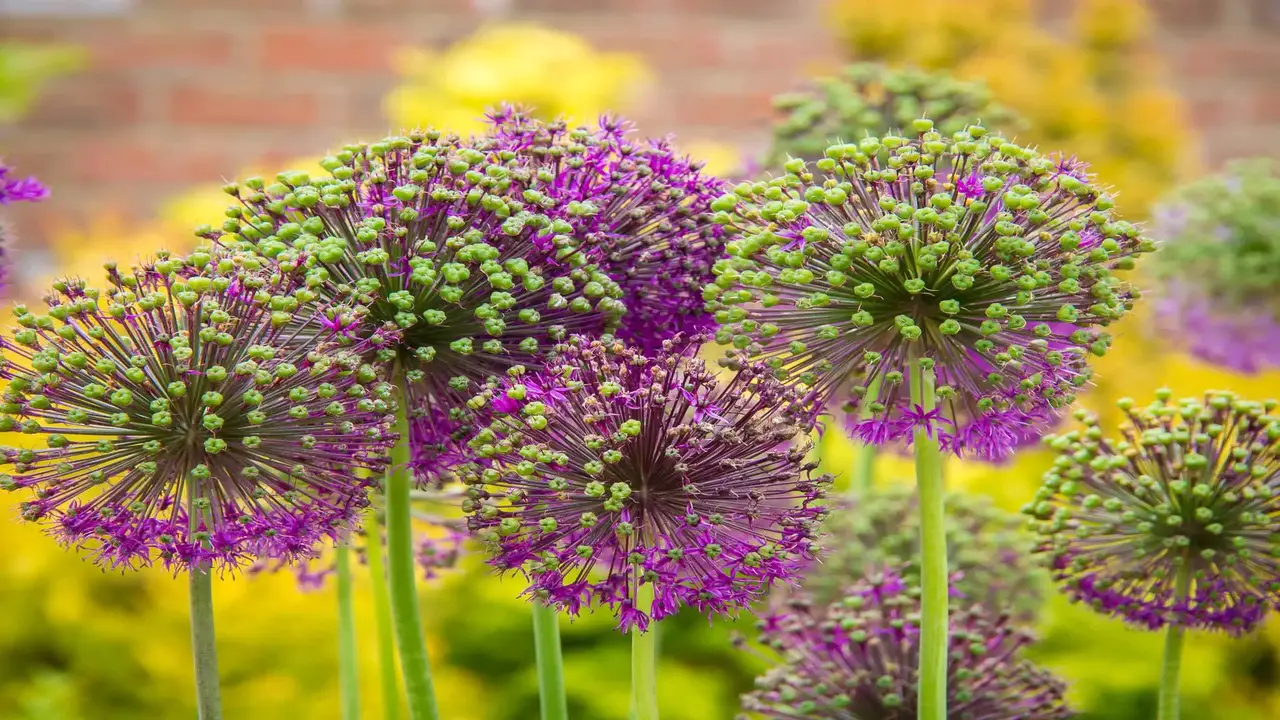
Addressing these common problems and providing proper care for your allium plants can ensure they thrive and add beauty to your garden. Troubleshooting Common Allium Growing Problems:
- Yellowing Foliage: If the leaves of your allium plants are turning yellow, it could be a sign of overwatering or poor drainage. Make sure the soil is well-drained and adjust your watering schedule accordingly.
- Lack Of Blooms: If your allium plants are not producing blooms, it may be due to insufficient sunlight or nutrients. Alliums prefer full sun, so ensure they get at least 6 hours of direct sunlight each day. Additionally, fertilize the plants with a balanced fertilizer to provide them with the necessary nutrients.
- Pests And Diseases: Alliums are generally resistant to pests and diseases but can still be susceptible to issues like onion thrips or fungal diseases. Monitor your plants closely for any signs of infestation or disease, and take appropriate measures to control them if necessary.
- Flopping Stems: Allium stems can sometimes become top-heavy and flop over. You can stake the plants or plant them in groups for support to prevent this. Alternatively, you can choose shorter varieties that are less likely to flop.
Harvesting And Storing Allium Seeds
Once your ornamental alliums have bloomed, you may be interested in harvesting the seeds to grow more plants. Harvesting allium seeds is a relatively simple process. Wait until the flower heads have dried and turned brown before cutting them off the stem.
Place the seed heads in a paper bag or envelope and allow them to dry for a few weeks. Once completely dry, gently shake the bag or envelope to release the seeds.
Store the seeds in a cool, dry place until you are ready to plant them. When planting allium seeds, remember that they can take several years to reach maturity and produce flowers, so patience is key. With proper care and attention, you can enjoy the beauty of ornamental alliums for years to come.
Conclusion
Ornamental alliums are a beautiful addition to any garden; with the right care, they can thrive and bloom year after year. From selecting the right varieties to planting techniques and maintenance tips, we have covered everything you need to know to grow and care for ornamental alliums in your garden successfully.
Remember to choose a location with well-draining soil, provide regular watering and fertilization, and mulch to protect the bulbs from extreme temperatures. Deadheading and pruning will encourage optimal growth, while keeping an eye out for common pests and diseases will help you address any issues promptly.
Whether you’re a seasoned gardener or just starting, incorporating ornamental alliums into your garden adds beauty and elegance. So get your hands dirty, follow our tips, and watch these stunning flowers bring your garden to life. We hope you understand how to plant and care for ornamental alliums.
Frequently Asked Questions
1.Do Ornamental Alliums Multiply?
Ans: Ornamental alliums can multiply. They can divide and form new bulbs underground, resulting in more plants. Some varieties of ornamental alliums can also self-seed and produce new offspring. To prevent overcrowding, dividing and replanting them every few years is recommended.
2.Should You Deadhead Alliums?
Ans: Deadheading alliums is not necessary, but it can improve their appearance. Removing spent flower heads redirects energy into the bulb for next year’s growth. Additionally, deadheading prevents self-seeding and keeps the plant from spreading too much.
3.Do Alliums Come Back Every Year?
Ans: Yes, alliums are perennial plants that return year after year. They thrive in well-draining soil and full sun. For spring blooms, plant allium bulbs in the fall. After flowering, deadhead the flowers to promote bulb growth and prevent self-seeding.
4.How Do You Dry Alliums?
Ans: To dry alliums, start by cutting the stems and removing any leaves. Then, bundle the stems and hang them upside down in a warm, well-ventilated area. Let them dry for a few weeks until thoroughly dried. Once dried, you can use them in arrangements or as decorative elements.
5.Do Alliums Grow In Shade?
Ans: While most alliums prefer full sun to grow and bloom, some varieties, like Allium ursinum, can tolerate partial shade. If you want to plant alliums in a shady area, ensure they receive at least four hours of direct sunlight daily. Research the specific variety you want to plant to determine its light requirements.






